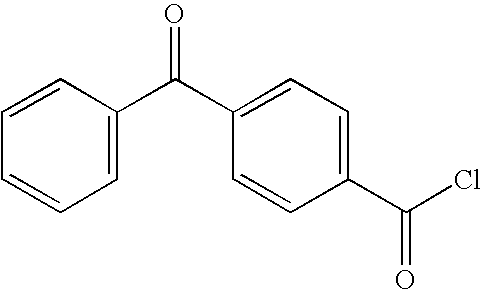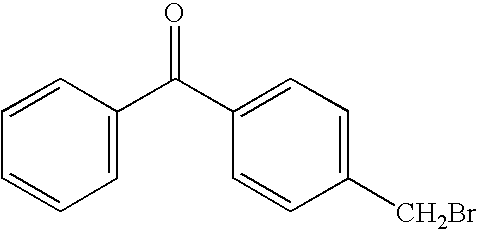Latent reactive blood compatible agents
a technology of reactive blood and compatible agents, applied in the direction of depsipeptides, packaging goods types, peptide/protein ingredients, etc., can solve the problems of anticoagulants with their own risks and drawbacks, and no approach has been shown to be universally applicable for improving blood-biomaterial interactions
- Summary
- Abstract
- Description
- Claims
- Application Information
AI Technical Summary
Benefits of technology
Problems solved by technology
Method used
Image
Examples
example 1
Preparation of 4-Benzoylbenzoyl Chloride (BBA-Cl) (Compound 1)
[0043]4-Benzoylbenzoic acid (BBA), 1.0 kg (4.42 moles), was added to a dry 5 liter Morton flask equipped with reflux condenser and overhead stirrer, followed by the addition of 645 ml (8.84 moles) of thionyl chloride and 725 ml of toluene. Dimethylformamide (DMF), 3.5 ml, was then added and the mixture was heated at reflux for 4 hours. After cooling, the solvents were removed under reduced pressure and the residual thionyl chloride was removed by three evaporations using 3×500 ml of toluene. The product was recrystallized from toluene / hexane (¼) to give 988 g (91% yield) after drying in a vacuum oven. Product melting point was 92-94° C. Nuclear magnetic resonance (NMR) analysis at 80 MHz was consistent with the desired product. The final compound was stored for use in the preparation of photoactivatable compounds, as described for instance in Examples 10 and 20.
example 2
Preparation of 4-Bromomethylbenzophenone (BMBP) (Compound 2)
[0044]4-Methylbenzophenone, 750 g (3.82 moles), was added to a 5 liter Morton flask equipped with an overhead stirrer and dissolved in 2850 ml of benzene. The solution was then heated to reflux, followed by the dropwise addition of 610 g (3.82 moles) of bromine in 330 ml of benzene. The addition rate was approximately 1.5 ml / min and the flask was illuminated with a 90 watt (90 joule / sec) halogen spotlight to initiate the reaction. A timer was used with the lamp to provide a 10% duty cycle (on 5 seconds, off 40 seconds), followed in one hour by a 20% duty cycle (on 10 seconds, off 40 seconds). At the end of the addition, the product was analyzed by gas chromatography and was found to contain 71% of the desired 4-bromomethylbenzophenone, 8% of the dibromo product, and 20% unreacted 4-methylbenzophenone. After cooling, the reaction mixture was washed with 10 g of sodium bisulfite in 100 ml of water, followed by washing with 3×...
example 3
Preparation of Poly(ethylene glycol)200 Mono-4-benzoylbenzyl Ether (Compound 3)
[0045]The poly(ethylene glycol)200 (PEG), 72.72 g (0.363 mol), was azeotroped with 200 ml of toluene for two hours to remove moisture, followed by the removal of excess toluene under vacuum. The PEG residue was then dissolved in 400 ml of anhydrous tetrahydrofuran (THF) while stirring under argon at 4° C. Sodium hydride, 2.90 g of a 60% mixture in mineral oil (72.5 mmol), was added in portions and the mixture was stirred 1 hour at room temperature. BMBP, 20.0 g (72.7 mmol), prepared according to the general method described in Example 2, was added as a solution in 100 ml of THF over a 2 hour period and the mixture was stirred 16 hours at room temperature under argon. The reaction was quenched with aqueous ammonium chloride (36 g in 200 ml of water) and the organic solvent was removed under vacuum. The residue was dissolved in brine, extracted with chloroform, and the resulting organic extracts were dried ...
PUM
| Property | Measurement | Unit |
|---|---|---|
| melting point | aaaaa | aaaaa |
| melting point | aaaaa | aaaaa |
| temperature | aaaaa | aaaaa |
Abstract
Description
Claims
Application Information
 Login to View More
Login to View More - R&D
- Intellectual Property
- Life Sciences
- Materials
- Tech Scout
- Unparalleled Data Quality
- Higher Quality Content
- 60% Fewer Hallucinations
Browse by: Latest US Patents, China's latest patents, Technical Efficacy Thesaurus, Application Domain, Technology Topic, Popular Technical Reports.
© 2025 PatSnap. All rights reserved.Legal|Privacy policy|Modern Slavery Act Transparency Statement|Sitemap|About US| Contact US: help@patsnap.com



